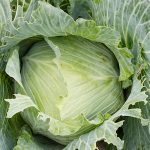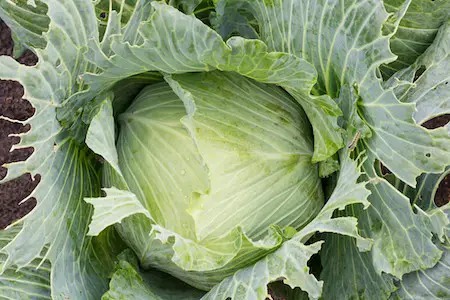Cabbage is a staple in many people’s diets. It can be eaten raw, cooked, or fermented and has a low glycemic index which means it won’t spike your blood sugar levels like other foods might. The nutritional benefits of cabbage are huge and include vitamins A, B6, C, K as well as potassium and fibre.
The leaves of the cabbage plant make excellent wrappers for tacos or burritos with rice filling. And when you’re done eating them you can compost the wrapper to make more soil for next year’s garden!
Cabbage is an amazing vegetable that serves as a major ingredient in salad and other recipes. While some kids may avoid eating cabbage, their beneficial nutrients make it worthwhile to insist that they have some in their diet often.
I personally love cabbages. Besides being nutritious, the plant is exceptionally beautiful; it will enhance the aesthetics of your garden.
The cabbage is rich and contains enough fibre as well as Vitamin C that’s good for one’s health. Growing cabbage in your garden is less complicated than you might think and self-fulfilling when you realise that your fresh harvested cabbage becomes an important ingredient in preparing some homemade dishes like sauerkraut, cabbage rolls and other regular dishes.
There are different kinds of cabbage available to select from. We all have the specific type we prefer and those are the ones we use to prepare our meals. Cabbages commonly found in grocery stores are red and green round heads. This class of cabbage belong to the Brassica oleracea group.
Cole crops are all descendants of wild cabbages; it covers all cultivated varieties in the Brassica Oleracea group.
Brassica oleracea is an extremely large family that contains important nutritional veggies including, kale, cauliflower, Brussels sprouts, broccoli and the like. Cabbages like Napa cabbage and Bokchoy are also varieties you can grow at a suitable location in your garden.
Starting with cabbage seeds
It’s not difficult to find seeds at the farmer’s market; you also have the option to purchase a young cabbage depending on which you prefer. Do make sure you follow all the instructions shown on your seed container, to know the appropriate time it’ll take the plant to mature.
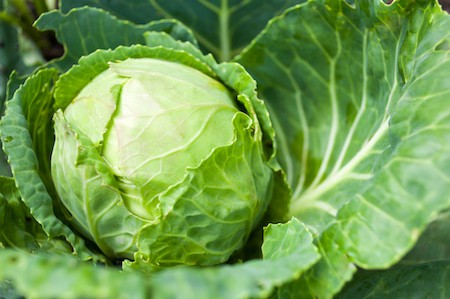
To plant, dig the soil to about ½ cm deep and put in your cabbage seeds, ensure that the number of seeds you put in each hole should be about three or a maximum of four seeds. Sunlight is required for the flourishing of cabbage plants; lack of sunlight causes the plant to be thin and lanky.
It will be wise to start your cabbage seeds beneath grow lights, at some point when they have attained few leaves move them to bigger containers or garden soil outdoors depending on which you prefer. It is also essential that you remove dwarfish or small cabbages and let the bigger ones grow.
Transferring your cabbage plants
If your cabbage has at least four sets of true leaves, you can move it to a wider or bigger pot.
Just in case you intend to plant sequentially, follow the steps to bury your seed in midsummer and expect it during fall. Otherwise, start cabbage seeds beneath your grow lights for a quick start in the summertime.
Planting young cabbages in your garden
Cabbages tend to flourish in cool weather, so deem it necessary to plant earlier than the warm loving plants like cucumbers and tomatoes. The instructions shown on your seed container can assist you to sum days from your area’s last frost date backwards. It is important to toughen your plant seeds, afterwards plant them in the soil.
Ensure that you find a suitable area to plant cabbage in your garden, a place that has enough sunlight and a well powdery or crumbled energised soil. To plant, make a spacing of 38 to 60cm between seedlings and space rows by 60 to 90cm. At this stage, they may look dwarfish in size, but as time goes on they’ll turn into large healthy plants and flourish till the end, and so spacing is essential as they will grow larger.
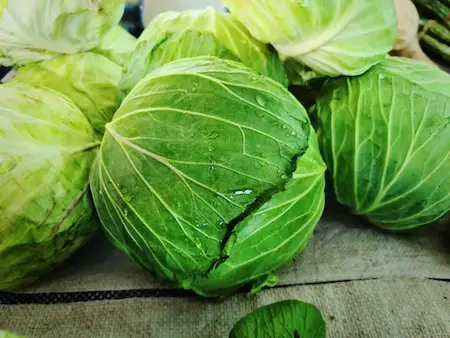
All plants need water to grow, so spray your water through a hose-end sprayer regularly. Some cabbages need fertilizers; say 21 to 28 days after planting, apply fertilisers to the soil. Ensure you remove unwanted plants (weed) growing around your cabbage, as they all struggle for sunlight and fibre. If you wish you can put together shredded leaves or straw and spread on the growing area.
Be on the lookout for pests
Pests are annoying creatures that feed on and harms your plants, it’s even more annoying when they get a taste of your cabbage before you do. Certain pests like; cabbage maggots, cutworms, and cabbage loppers tend to attack cabbages. There are some methods for controlling pests that you ought to learn if you want to protect your plants.
Homemade cardboard collar around cabbage
This technique is used to prevent cabbage root flies from attacking cabbage plants. These persistent creatures later develop into mature maggots and stay underneath plants roots feeding off of its nutrient. When compared to a housefly they are smaller in size, with few bristle hairs on them.
This homemade cardboard is made with frozen pizza; you can learn how to make this cardboard easily.
Growing cabbage beneath row covers for prevention of pest attack
When you have your young cabbage plants ready to be transplanted, you can mount your beds to an average height, put in your cabbages and seal them from above with a suspended row cover. You can try it with other veggies like kale and broccoli.
Cabbage worms and other pests feed on cabbage plants during their season and these could affect their health and development.
Using the suspended row cover is an effective way to reduce attacks caused by worms by preventing adults from laying eggs all over the plants. The row covers can be spread over kale and Brussels sprouts as these pests are also attracted to other veggies in the cabbage family as well.
Cabbage worms can inflict much damage to your Brassica
Cabbage worms can cause serious damage to vegetables; they can transform the healthy nature of your plant into a brown, patchy mess. You can handpick these worms when found on your plants.
The suspended row cover is made in such a way that sun rays pass through it because sunlight plays an important role in the growth of cabbages. Ensure that you water your cabbages regularly. You’ll need to take off the row covers when you do this and fix them back afterwards.
Knowing the right time to harvest cabbage heads
Follow the instructions on your seed container to know the actual weight of a well-developed cabbage; it has an estimated weight of 1-3 pounds. The top ought to feel sturdy, make use of a knife to cut cabbage heads from the bottom.
When your cabbage has reached the stage of maturity where it’s ready to be harvested, cut it in a way that the rest of the plants does not come along with it. If you are sure that your cabbage has no disease, leave the cabbage on the soil for another head to emerge from it.
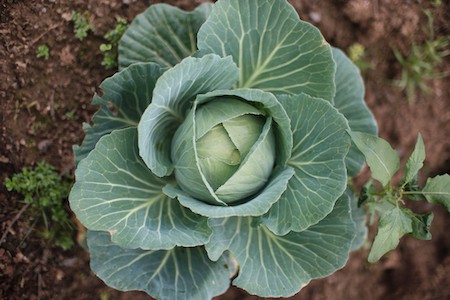
When your cabbage divides during its growing season, it’s an indicator of intense rainfall or lack of water. Although, if you have a situation like this, you should cut the cabbage (harvest) from the plant.
Selecting from different cabbage varieties
If you’re trying to find the best cabbage variety to grow in your region, you can always do some research as we all have the type of cabbage we prefer. For instance, some gardeners will prefer cabbages that develop fast; the jersey Wakefield and Earlina are examples of fast-growing varieties.
In case you are doubtful about the type of cabbage to grow, you can seek help from well-experienced farmers and anyone quite knowledgeable on the subject. If not, you can make a decision yourself and select whichever you feel is right for you. If you have insufficient planting area in your home garden, you should grow smaller varieties suitable for your environment.
Final Thoughts
Cabbage is one of the most popular vegetables to grow. You can harvest it early and you’ll find it’s versatile in recipes. Growing cabbage doesn’t have to be difficult, but there are a few things that will make your growing experience easier.
You should try growing some cabbages in your garden if you have never done so before. Don’t you want to cut back on purchasing not-so-fresh cabbages from the grocery store each time you need some? With the tips above, you should be able to find a perfect variety and get started on the growth journey.
It might just be that you already have some favourites? Well, what are you waiting for? Get started!


